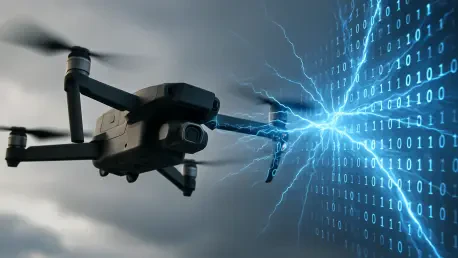In an era where drones are transforming industries like delivery, agriculture, and disaster response, the looming threat of cyberattacks has cast a shadow over their potential, with hackers capable of hijacking these devices and causing catastrophic failures. Drones, once seen as mere gadgets, now play critical roles in inspecting infrastructure and aiding in emergencies, making their security a top priority. However, the sophistication of cyber threats, from GPS spoofing to malware infiltration, has outpaced traditional defenses, leaving missions vulnerable to disruption or complete failure. Amid this growing concern, a groundbreaking solution has emerged from researchers at Florida International University, offering a new layer of protection that could redefine safety in the skies. This innovation, known as SHIELD, tackles the vulnerabilities head-on, promising not just to detect attacks but to ensure drones can recover and complete their tasks even under duress.
Addressing the Rising Threat of Drone Cyberattacks
Unmasking the Vulnerabilities in Drone Systems
The rapid integration of drones into critical operations has exposed a glaring weakness: their susceptibility to stealthy cyberattacks that can manipulate navigation or crash systems entirely. Hackers often exploit techniques like GPS spoofing, feeding false location data to mislead drones off course, while more insidious malware can infiltrate internal software, bypassing conventional safeguards. Traditional defenses, heavily reliant on navigation sensors, fail to address threats targeting deeper system components, leaving drones defenseless against sophisticated intrusions. This gap in security poses risks not only to mission success but also to public safety, as a compromised drone could endanger lives or disrupt essential services. As industries push for broader drone adoption, the urgency to fortify these devices against unseen digital threats becomes undeniable, highlighting the need for a more robust and comprehensive approach to cybersecurity.
Why Current Defenses Fall Short
While sensor-based protections have been the cornerstone of drone security, their limitations are becoming increasingly apparent in the face of evolving cyber threats. These systems often focus narrowly on external inputs like location data, missing internal anomalies caused by malware or hardware tampering that can silently undermine operations. Even when an attack is detected, the lack of effective recovery mechanisms means drones are typically grounded as a precaution, resulting in mission failure. Such shortcomings are particularly concerning in high-stakes scenarios, such as disaster response, where every second counts. Experts argue that a fragmented approach to security, ignoring the interplay between software and hardware, leaves drones exposed to risks that could have far-reaching consequences. This reality underscores the critical demand for an integrated defense strategy capable of addressing the full spectrum of potential vulnerabilities.
SHIELD: A Game-Changing Solution for Drone Security
Holistic Monitoring for Unparalleled Protection
SHIELD emerges as a pioneering force in drone cybersecurity, offering a multi-layered defense that sets it apart from traditional systems by monitoring not just sensors but the entire ecosystem of hardware and software. This innovative framework tracks subtle indicators like battery fluctuations and processor strain to detect malicious activity in real time, catching threats before they escalate into serious damage. Unlike older methods that react only after an attack disrupts navigation, SHIELD’s comprehensive approach ensures that even the most covert intrusions are identified through physical evidence across the drone’s systems. This capability is vital for industries relying on drones for sensitive tasks, as it minimizes downtime and prevents catastrophic failures. By addressing vulnerabilities at every level, SHIELD provides a level of protection that aligns with the growing complexity of cyber threats, paving the way for safer and more reliable drone operations.
Rapid Detection and Recovery in Action
One of SHIELD’s most impressive features is its speed, with testing demonstrating an ability to detect cyberattacks in an average of 0.21 seconds and initiate recovery in just 0.36 seconds, ensuring minimal disruption to missions. Leveraging machine learning models, the system is trained to recognize distinct attack patterns, allowing it to pinpoint threats with precision and deploy tailored response plans mid-flight. This rapid reaction capability marks a significant leap forward, as it prevents drones from being grounded unnecessarily and enables them to resume normal operation despite being targeted. The importance of such efficiency cannot be overstated, especially in time-sensitive applications like emergency response or critical deliveries. SHIELD’s focus on both detection and recovery addresses a long-standing gap in drone security, offering a practical solution that keeps missions on track even under the pressure of a cyberattack.
Shaping the Future of Safe Drone Operations
Looking ahead, SHIELD’s impact on the drone industry appears transformative, as its ability to safeguard against evolving threats aligns with the expanding role of drones in sensitive environments. The system’s success in testing suggests it could become a standard for cybersecurity, fostering trust in autonomous technologies across sectors. Researchers emphasize that secure drones are essential for unlocking future innovations, from urban air mobility to advanced agricultural monitoring. As cyber risks continue to grow, adopting solutions like SHIELD will be crucial for protecting operations and ensuring public safety over the coming years. This technology not only addresses immediate vulnerabilities but also sets a precedent for proactive defense strategies that could inspire broader advancements in the field.
Building Trust Through Innovation
Reflecting on the journey, SHIELD’s development marked a pivotal moment in confronting the hidden dangers that threatened to undermine the potential of drones in vital industries. Its integration of hardware and software monitoring, paired with lightning-fast response times, established a new benchmark for what drone security could achieve. The collaborative insights from the research team highlighted the importance of a system-wide perspective, proving that isolated defenses were no match for sophisticated attacks. By enabling drones to recover mid-flight, this solution ensured that missions once doomed to fail could be salvaged, preserving both functionality and safety. As industries looked to expand drone usage, the groundwork laid by SHIELD offered a clear path forward—investing in comprehensive cybersecurity to protect the skies and embracing cutting-edge tools to stay ahead of emerging threats.









